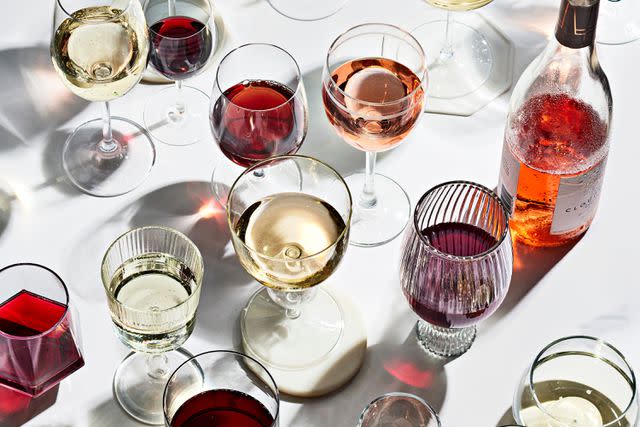How to Choose a Good Wine, Even If You're Just Guessing
- Oops!Something went wrong.Please try again later.
You don't have to be an expert to pick the best bottles of wine. These expert tips will steer you in the right direction.
In a perfect world, we’d all be armchair sommeliers. We’d have just the right words to describe a single sip of pinot. We’d know what to pair with a homemade pizza. And we’d recognize the difference between this chardonnay and that one. In reality, most of us just buy what we’ve had a hundred times, or we pick by price or—yikes—label. That’s where I come in! I can’t go with you to the wine store, but I can share some easy tricks to help you before you go.

Victor Protasio
Skip the Super Cheap Stuff
The quickest way to make sure you’re getting a decent bottle is to spend at least $10 a pop. “Many cheaper wines start with subpar fruit and need to make up for it on the back end, so they’re full of additives,” says Brianne Cohen, a Los Angeles–based certified sommelier and a judge at international wine competitions. Plus, so many elements go into producing wine (labor, land management—even label design) that Cohen says it’s almost impossible to make a good-quality one priced at less than $10 a bottle.
Broaden Your Horizons
“If you look beyond the most famous wine regions, you can often get more for your money,” says Kate Leahy, author of Wine Style, a guide to figuring out which varietals you like, with recipe pairings. “If you like Napa cabernets but not their usual high price tags, consider cabs from Australia.” Also, keep an eye out for wines from Portugal and Spain, two countries where good wine is often underpriced compared with more famous—and highly marketed—wine producers, like France and the United States.
Read the Fine Print
We’d be robots if we didn’t respond to those cool, artistic labels on the fronts of bottles! Just remember to also turn the bottle around. Leahy checks the back label to see where the wine hails from— the more specific the location, the better the wine (usually). “If a bottle of pinot noir says California, great. California Central Coast, even better. Santa Barbara, California, even better.” If you’re drinking a foreign bottle and you like it, note the name of the importer. “That way, you can seek out other wines they import,” Leahy says, because importers tend to maintain standards across their portfolios.
Zachary Sussman, author of The Essential Wine Book, also suggests looking for phrases like “estate bottled” on American wines and “mis en bouteille au château” on French wines. These terms mean the winemaker had control of the entire process, from grape growing to wine bottling. “Chances are, the wine was made by a smaller, often family-run estate that puts care into it, not some giant conglomerate that might put less emphasis on quality,” Sussman says.
Pay Attention to Colors
If you know you like crisp, refreshing whites, scope out the store for paler wines, Leahy says. If you prefer richer, more buttery whites, look for wines more golden in color. While this trick won’t work 100 percent of the time, it can help you narrow down your choices. You can shop rosés by color too, Leahy “There are exceptions, but looking at the color is a good way to get a sense of what’s in the bottle.”
Pull Out Your Phone
There’s an app for everything these days— including wine shopping. Cohen likes Vivino (free; iOS and Android), which scans the label and provides crowdsourced data and reviews for that particular bottle, a boon when you’re choosing between a dozen or more bottles of sauv blanc. “Vivino really comes in handy once you start inputting your own ratings and tasting notes. The system will analyze your preferences to help steer you toward a bottle you’ll enjoy,” she adds.
Be Adventurous
This might sound odd, considering I’m trying to help you pick a winner, but both Leahy and Cohen recommend going outside your comfort zone at times…even if you end up with a bottle you wouldn’t buy again. “The next time you shop, grab something you love, but also something you’ve never tried,” Cohen says. If you find the wine undrinkable, freeze it in ice cube trays and use it for future deglazing and braises. Any fails will be worth it, if they get you closer to knowing exactly what you love.
For more Real Simple news, make sure to sign up for our newsletter!
Read the original article on Real Simple.

